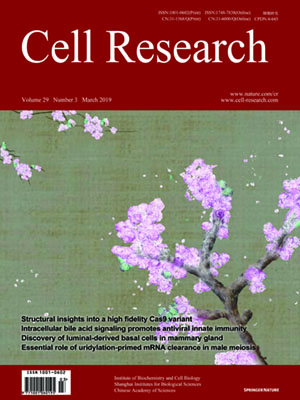
Volume 29, No 3, Mar 2019
ISSN: 1001-0602
EISSN: 1748-7838 2018
impact factor 17.848*
(Clarivate Analytics, 2019)
Volume 29 Issue 3, March 2019: 206-220
ORIGINAL ARTICLES
Hormones induce the formation of luminal-derived basal cells in the mammary gland
Wenqian Song 1, Ran Wang 1, Weimin Jiang 1, Qi Yin 1, Guangdun Peng 2,3, Ruikai Yang 1, Qing Cissy Yu 1, Jianfeng Chen 1, Jingsong Li 1,Tom H. Cheung 4, Naihe Jing 1 and Yi Arial Zeng 1
1State Key Laboratory of Cell Biology, CAS Center for Excellence in Molecular Cell Science, Shanghai Institute of Biochemistry and Cell Biology, Chinese Academy of Sciences, University of Chinese Academy of Sciences, 320 Yueyang Road, Shanghai 200031, China; 2CAS Key Laboratory of Regenerative Biology and South China Institute for Stem Cell Biology and Regenerative Medicine, Guangzhou Institutes of Biomedicine and Health, Chinese Academy of Sciences, Guangzhou 510530, China; 3Guangzhou Regenerative Medicine and Health Guangdong Laboratory (GRMH-GDL), Guangzhou 510005, China and 4Division of Life Science, Center for Stem Cell Research, Center for Systems Biology and Human Health, the State Key Laboratory in Neuroscience, Hong Kong University of Science & Technology, Kowloon, Hong Kong, China
Correspondence: Yi Arial Zeng (yzeng@sibcb.ac.cn)These authors contributed equally: Wenqian Song, Ran Wang
In the mammary gland, it is widely believed that the luminal cells are unipotent after birth, contributing only to the luminal compartment in normal development. Here, by lineage tracing, we uncovered an unexpected potential of luminal cells that can give rise to basal cells during pregnancy. These luminal-derived basal cells (LdBCs) persisted through mammary regression and generated more progeny in successive rounds of pregnancies. LdBCs express basal markers as well as estrogen receptor α (ERα). In ovariectomized (OVX) mice, stimulation with estrogen and progesterone promoted the formation of LdBCs. In serial transplantation assays, LdBCs were able to reconstitute new mammary glands in a hormone-dependent manner. Transcriptome analysis and genetic experiments suggest that Wnt/β-catenin signaling is essential for the formation and maintenance of LdBCs. Our data uncover an unexpected bi-potency of luminal cells in a physiological context. The discovery of ERα+ basal cells, which can respond to hormones and are endowed with stem cell-like regenerative capacity in parous mammary gland, provides new insights into the association of hormones and breast cancer.
https://doi.org/10.1038/s41422-018-0137-0
FULL TEXT | PDF
Browse 1294


